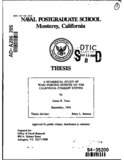Light propagation in biaxial nematic liquid crystal polymers using the finite-difference time-domain method
| dc.contributor.author | Choate, Eric P. | |
| dc.contributor.author | Zhou, Hong | |
| dc.date.accessioned | 2014-04-18T18:03:44Z | |
| dc.date.available | 2014-04-18T18:03:44Z | |
| dc.date.issued | 2011 | |
| dc.identifier.uri | https://hdl.handle.net/10945/40835 | |
| dc.description.abstract | We examine the propagation of electromagnetic waves across a liquid crystal polymer (LCP) domain using the finite-difference time-domain (FDTD) method. In the limit of perfect LCP alignment, the order parameter s approaches unity, and the LCP recovers a uniaxial alignment completely described by the major director n given by Leslie-Ericksen theory. We use a Doi-Marrucci-Greco tensor model formulation for the LCP orientation to examine the effect of less-than-perfect alignment. In a one-dimensional system with the orientation allowed to vary across the gap between two glass plates, we first examine uniaxial orientations for which s<1, and then we examine the effects of biaxial orientations, and in each case, we look at the role of using different anchoring directions at the two plates, which can induce deformations in the major director. Also, we examine oblate defect phases in which the sample is not isotropic but still fails to have a well defined major director. | en_US |
| dc.rights | This publication is a work of the U.S. Government as defined in Title 17, United States Code, Section 101. Copyright protection is not available for this work in the United States. | en_US |
| dc.title | Light propagation in biaxial nematic liquid crystal polymers using the finite-difference time-domain method | en_US |
| dc.type | Article | en_US |
| dc.contributor.department | Applied Mathematics | |
| dc.subject.author | Liquid crystal polymers | en_US |
| dc.subject.author | Light propagation in anisotropic media | en_US |
| dc.subject.author | Finite-Difference Time-Domain method | en_US |





